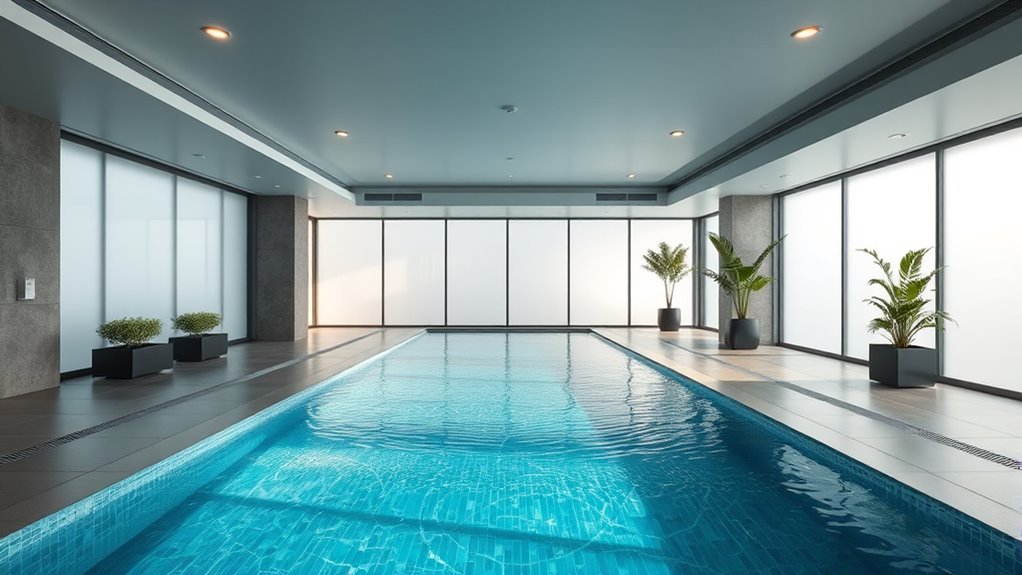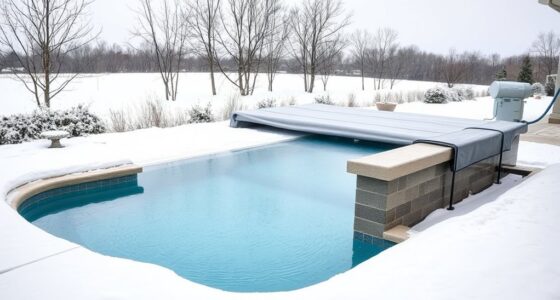Yes, you can install an endless pool indoors, but it requires careful planning. Make certain your space has enough room with proper ceiling height and strong flooring to support weight. Good ventilation and moisture management are essential to prevent mold and damage. Focus on safe designs with non-slip surfaces, proper lighting, and accessibility features. With the right structural and environmental setup, your indoor endless pool can be both functional and stylish — explore more tips to make it perfect.
Key Takeaways
- Ensure sufficient ceiling height, structural support, and space for safe access and installation of an indoor endless pool.
- Install effective ventilation and dehumidification systems to manage humidity and prevent mold growth.
- Choose durable, waterproof finishes and non-slip surfaces for safety and longevity in indoor environments.
- Incorporate proper lighting, safety features, and accessibility considerations for user comfort and safety.
- Regularly monitor moisture levels, maintain equipment, and ensure proper airflow to sustain a healthy indoor pool environment.
Assessing Space and Structural Requirements
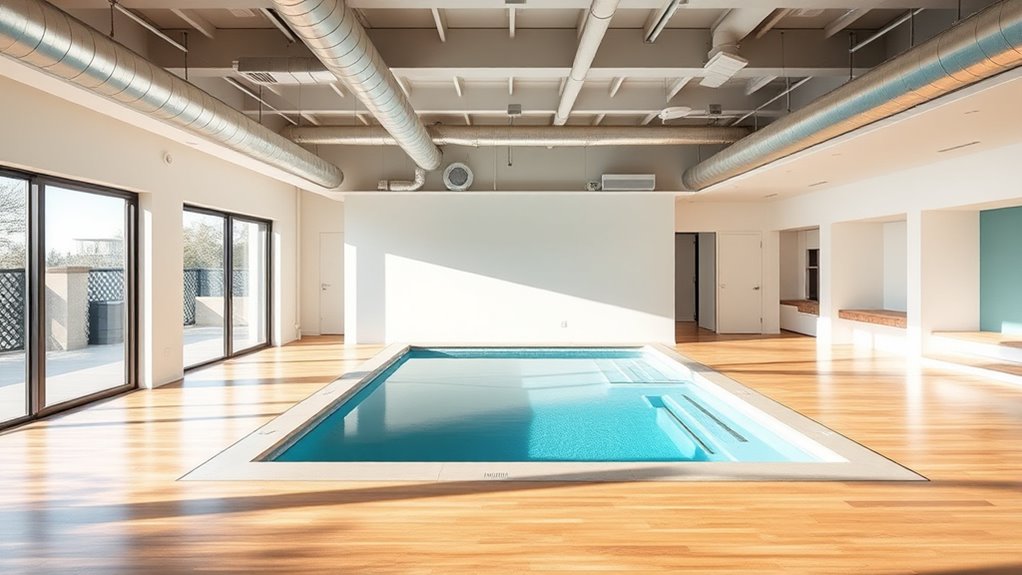
Before installing an endless pool indoors, you need to carefully evaluate your available space and the building’s structural capacity. Measure the area where you plan to place the pool, ensuring there’s enough room for safe access and movement around it. Check the ceiling height to accommodate the pool’s depth and any necessary equipment. You’ll also need to assess the weight load; an indoor pool can be heavy when filled, so verify that your floors can support this weight without risking damage. Consider existing support beams, load-bearing walls, and the floor’s construction. If your space isn’t initially suitable, you might need structural reinforcements or modifications. Proper assessment prevents costly mistakes and guarantees your indoor pool is safe, functional, and compliant with building codes. Understanding load capacity is crucial to ensure your space can handle the weight of a filled pool safely.
Ensuring Proper Ventilation Systems
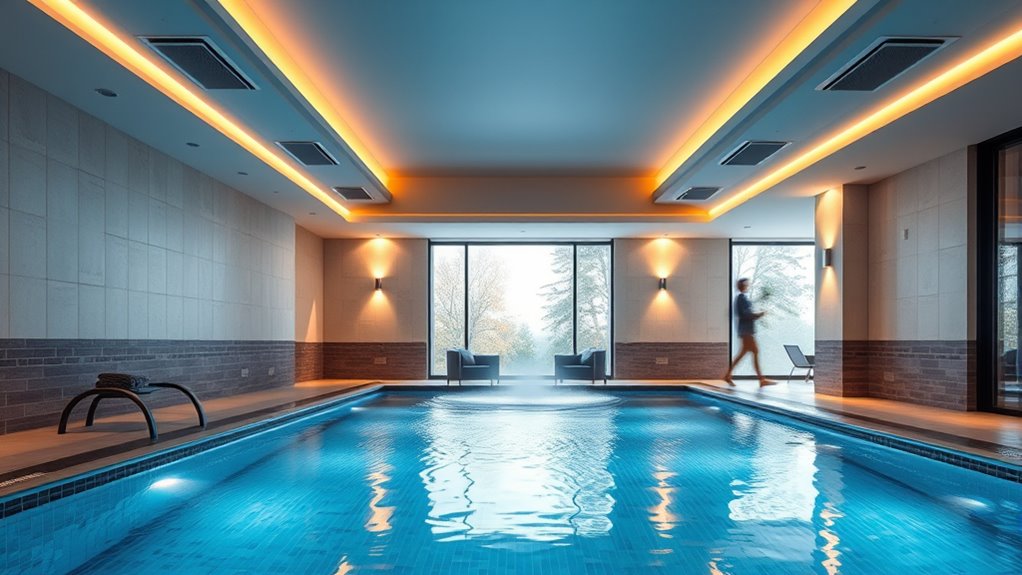
Proper ventilation is essential to maintaining a comfortable and safe indoor pool environment, especially since humidity levels can rise quickly and cause damage or health issues. You need a ventilation system that effectively exchanges indoor air with fresh outdoor air, preventing excess moisture buildup. Installing an exhaust fan or an energy recovery ventilator (ERV) helps remove humid air and brings in fresh air without losing energy. Make sure your system is appropriately sized for the space and designed for continuous operation. Regular maintenance, like cleaning filters and checking airflow, keeps the system running efficiently. Proper ventilation not only controls humidity but also reduces odors and airborne contaminants, ensuring a healthier environment for you and anyone using the pool. Choosing the Best Portable Inverter Generator for Your Needs
Managing Humidity and Moisture Levels

Controlling humidity and moisture is essential to keep your indoor pool area comfortable and safe. You can do this by using strategies like dehumidifiers and proper ventilation, which help reduce excess moisture. Additionally, applying moisture prevention techniques—such as sealing leaks and maintaining proper airflow—ensures your space stays dry and protected. Incorporating Gold IRA options can also provide long-term financial security should you choose to invest in assets like precious metals for future planning.
Humidity Control Strategies
Maintaining ideal humidity levels is essential for your indoor endless pool, as excessive moisture can lead to mold growth, damage, and discomfort. To control humidity effectively, use dehumidifiers with adjustable settings to keep moisture in check. Ventilation systems, like exhaust fans, help remove humid air and replace it with drier air from outside. Monitoring with a hygrometer ensures you stay within the suitable range of 50-60%. Consider the following strategies:
| Strategy | Benefit |
|---|---|
| Dehumidifiers | Reduce excess moisture quickly |
| Proper Ventilation | Maintain airflow, prevent stagnation |
| Humidity Monitoring | Keep levels within safe, comfortable range |
Implementing these measures not only improves comfort but also aligns with home organization practices that promote a clutter-free and well-maintained environment.
Moisture Prevention Techniques
To prevent excess moisture from compromising your indoor endless pool, it’s essential to implement effective moisture prevention techniques. Proper insulation helps maintain stable temperatures, reducing condensation buildup. Using a dehumidifier consistently pulls excess moisture from the air, keeping humidity levels in check. Ensuring your ventilation system is properly maintained allows fresh air to circulate, preventing humidity from stagnating. Additionally, promptly drying any water spills or splashes minimizes moisture accumulation on floors and walls. Regularly inspecting and maintaining your ventilation systems ensures optimal airflow and moisture control.
- Install a high-quality dehumidifier tailored to your space
- Use exhaust fans during and after pool use
- Seal gaps and leaks around windows and doors
- Regularly inspect and maintain your ventilation system
Choosing the Right Location Within Your Home
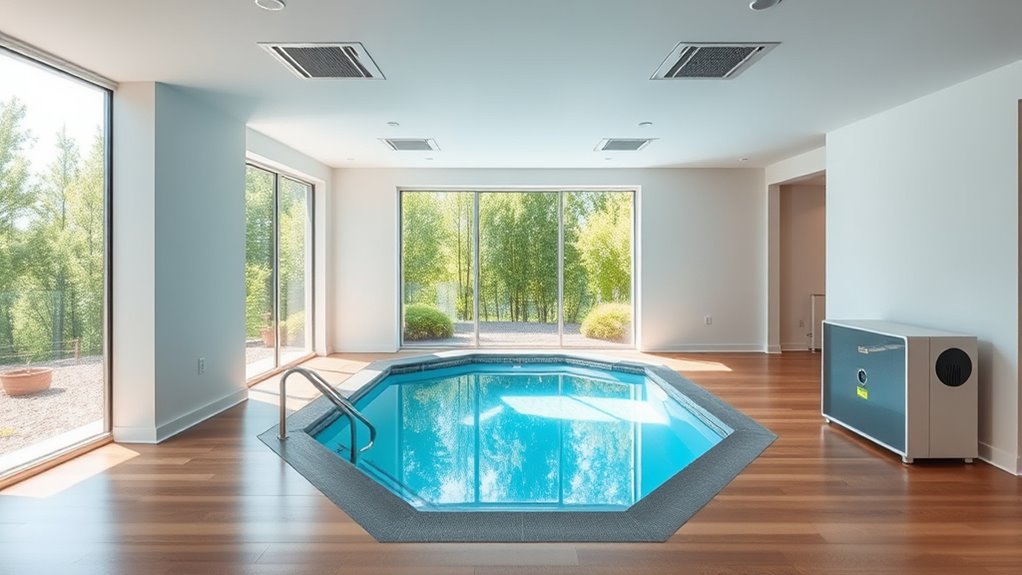
Choosing the right spot for your indoor pool is vital for safety and convenience. You should consider rooms with enough space and stable structures to support the weight. Evaluating structural integrity and layout will guarantee your pool fits seamlessly into your home. Additionally, selecting a location with adequate ventilation and moisture control is essential to prevent humidity buildup and maintain a comfortable environment.
Optimal Room Placement
Selecting the ideal spot for your indoor endless pool is essential to maximizing its benefits and ensuring smooth integration into your home. You want a location that balances convenience, safety, and functionality. Consider proximity to changing areas, access to electrical outlets, and natural light. The space should have enough room for maintenance and movement without feeling cramped. Proper placement also involves minimizing noise disruption and avoiding areas prone to drafts or temperature fluctuations. A well-chosen spot can improve your overall experience and help maintain the pool’s condition. Additionally, ensuring adequate ventilation is crucial to control moisture and humidity levels effectively.
Structural Considerations
The structural aspects of your home play a significant role in determining the best location for an indoor endless pool. You need to guarantee the floor can support the weight of the water, equipment, and users. Consult a structural engineer to verify load-bearing capacity and avoid placing the pool on upper floors not designed for heavy loads. Additionally, consider proximity to existing plumbing and electrical systems to simplify installation. Wall and floor stability are vital to prevent shifting or damage over time. You should also evaluate ceiling height—adequate space is essential for ventilation systems and easy access. Proper planning and assessment of building materials and construction can help ensure your space is suitable for an indoor pool installation. By thoroughly analyzing your home’s structural integrity, you’ll choose a location that’s safe, functional, and built to handle the long-term demands of an indoor pool.
Designing for Safety and Accessibility
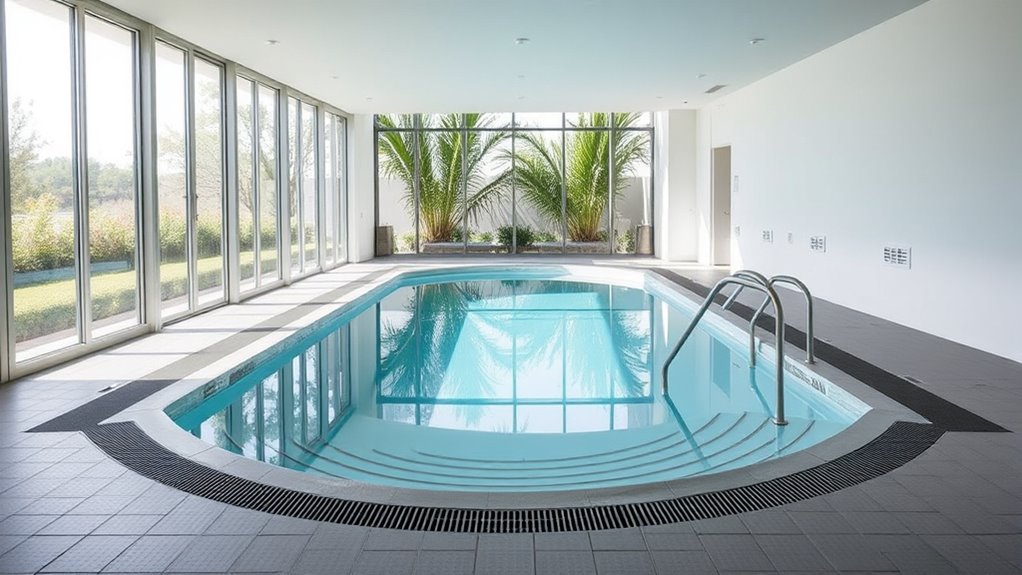
To guarantee safe and accessible use of your indoor endless pool, it’s essential to incorporate thoughtful design features from the outset. Prioritize clear pathways around the pool to prevent tripping hazards and ensure easy access for all users. Install non-slip flooring to reduce slips when wet, and include handrails or grab bars at strategic points for added support. Adequate lighting is vital to improve visibility and prevent accidents. Additionally, consider the height and placement of controls and access points to accommodate users with varying mobility levels. Incorporating core personality traits into your design considerations can also promote a more welcoming environment for diverse users.
Considering Aesthetic and Functional Enhancements
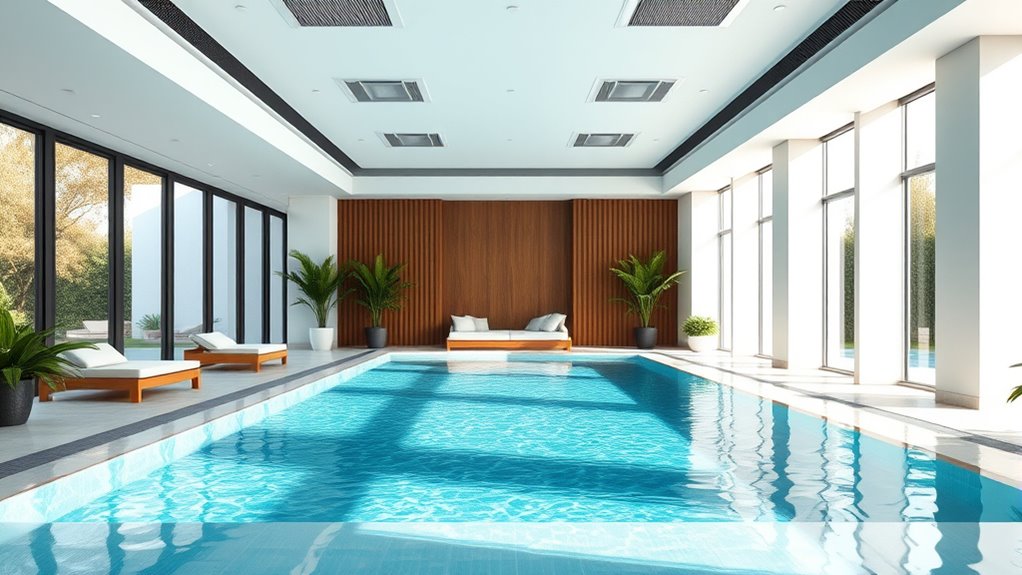
Enhancing your indoor endless pool with thoughtful aesthetic and functional features creates a space that’s both beautiful and practical. You can incorporate design elements that blend seamlessly with your decor while adding convenience. For example, lighting options set the mood, and built-in storage keeps essentials organized. To elevate the environment, consider using natural materials or sleek modern finishes. A well-designed surround can also improve safety and comfort. Here’s a quick overview:
| Feature | Purpose | Example Ideas |
|---|---|---|
| Lighting | Ambiance and visibility | LED mood lighting, adjustable |
| Storage Solutions | Clutter reduction | Hidden cabinets, shelving |
| Material Finishes | Style and durability | Natural stone, waterproof wood |
| Ventilation Features | Moisture control | Exhaust fans, dehumidifiers |
Incorporating proper ventilation is essential for maintaining optimal humidity levels, which directly impacts the longevity and comfort of your indoor pool environment. These enhancements make your space more inviting and functional.
Maintenance and Long-Term Care for Indoor Pools
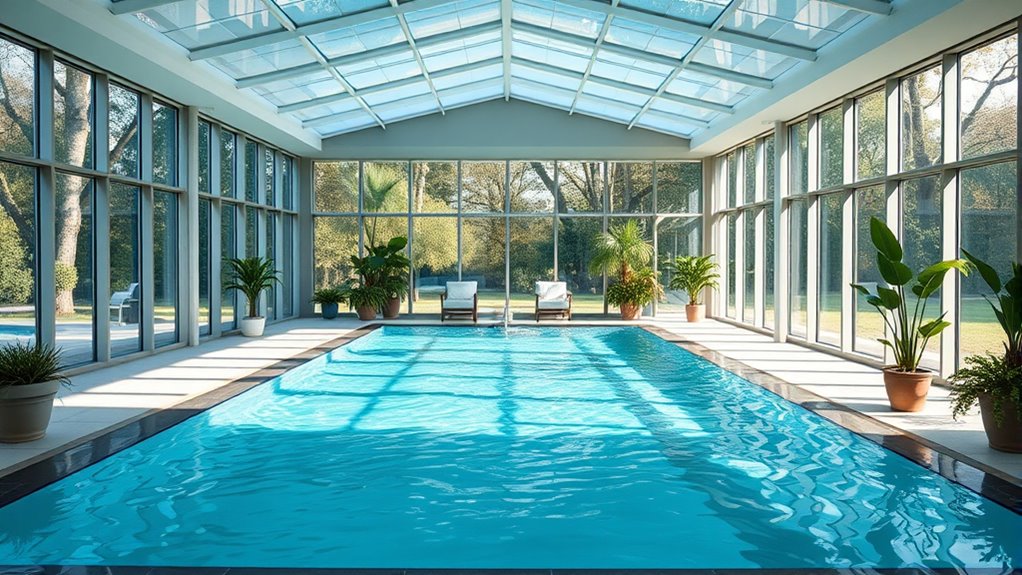
Maintaining your indoor pool requires consistent attention to guarantee it stays clean, safe, and in ideal condition over time. Regularly check and balance the water chemistry to prevent algae growth and skin irritation. Clean filters and skimmers frequently to ensure proper circulation and clarity. Keep humidity levels in check to prevent mold and structural damage, using dehumidifiers if necessary. Additionally, inspect the pool’s surface and equipment for signs of wear or corrosion.
- Test and adjust pH, chlorine, and alkalinity weekly
- Clean filters and skimmer baskets regularly
- Monitor humidity and ventilation systems
- Inspect for leaks, cracks, or equipment issues
Frequently Asked Questions
What Are the Insurance Implications of Installing an Indoor Endless Pool?
Installing an indoor endless pool can impact your insurance, potentially increasing premiums due to water damage risks. You might need to update your policy to cover potential leaks, mold, or structural issues. Check with your insurer before installation to make sure you’re adequately protected and avoid surprises. Proper ventilation and moisture control are essential, and documenting safety measures can help mitigate insurance concerns and demonstrate responsible management of your indoor pool.
How Does Indoor Installation Affect Home Resale Value?
Installing an indoor endless pool can boost your home’s resale value if you highlight its luxury and fitness benefits. However, it might deter some buyers if they worry about space, moisture issues, or maintenance costs. To maximize value, guarantee proper ventilation, moisture control, and attractive design. You also want to clearly communicate the pool’s benefits, making it a desirable feature that appeals to health-conscious or luxury-seeking buyers.
Are There Specific Building Codes for Indoor Pools in Residential Areas?
While there aren’t universal building codes specifically for indoor pools, you’ll need to adhere to local regulations that cover plumbing, electrical work, and safety standards. It’s wise to consult your city’s building department early in the planning process. They can guide you on necessary permits, ventilation requirements, moisture control, and structural considerations, ensuring your indoor pool installation is both compliant and safe, creating a luxurious yet responsible addition to your home.
Can an Indoor Pool Be Used Year-Round in All Climates?
Yes, you can use an indoor pool year-round in most climates, but it depends on proper insulation, ventilation, and temperature control. You need to maintain consistent water and air temperatures to prevent mold and moisture issues. In colder climates, make sure your heating system is robust enough to keep the pool warm. Regular maintenance and humidity management are essential to enjoy your pool comfortably and safely throughout the year.
What Are the Best Flooring Options Around Indoor Pools for Safety?
You should choose slip-resistant flooring around your indoor pool to guarantee safety. Options like textured ceramic tiles, rubber flooring, or epoxy coatings provide good grip and durability. Avoid smooth surfaces that can be slippery when wet. Consider installing drainage systems or mats to prevent water accumulation. Regularly clean and maintain the flooring to keep it safe and prevent mold or mildew growth. Prioritize safety with proper flooring choices to enjoy your indoor pool worry-free.
Conclusion
Bringing an endless pool indoors is like fitting a secret oasis into your home’s heartbeat. With careful planning around space, ventilation, and moisture, you create a sanctuary that’s both functional and beautiful. Think of it as crafting a timeless retreat where every splash renews your spirit. When you prioritize safety and maintenance, your indoor pool becomes a lasting treasure—an inviting escape that adds endless joy and refreshment to your everyday life.
